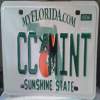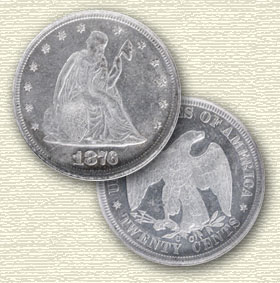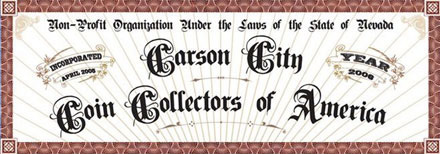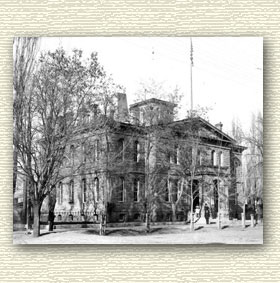- Posts: 176
- Thank you received: 0
1873 $20 Gold Carson City Coin of the Week 5-8- 2011
14 years 7 months ago #2533
by randysc
1873 $20 Gold Carson City Coin of the Week 5-8- 2011 was created by randysc
1873 was a peculiar year for the Carson City Mint. Production totals were steadily increasing with each year and in 1873 the Mint reached over a half of a million coins produced.It was the first year for the Trade Dollar, though that year the Carson city Mint would come in third in Trade Dollar production of the three mints in operation. The next few years would keep the C.C. mint more active in Trade Dollar production.
In February of 1873, the Federal Government passed an act that made gold as the country's monetary standard. It demonitized silver money making dimes, quarters and half dollars, (no dollars for general use were being produced) only to be used as legal tender in transactions of less that five dollars. The law ceased the existance of the circulating silver dollar with the exception of the Trade Dollar, which the primary objective for it was to be used for commerce in the Orient. The Act stopped free coinage and would cause the price of silver to fall. The pro silver people called it the "Crime of 1873". It would be so until 1878 when a circulating silver dollar production resumed and silver was again monetized.
In May of 1873, Frank Hetrich took aver the helm as Superintendent of the Carson City Mint replacing Henry F. Rice. Rice seemed to have a shadow of suspicion that follow him about. When he stepped down there were some lightweight debased C.C. coins dated 1872 and 1873 that were discovered, adding to his questionable integrity. I don't know of any charges of deceit were brought forth against him.
On October 19, 1873, the founder of Carson City, the Father of the Carson City Mint, the Curry Company Fire House and one half of the original owners of the Gould and Curry mine, one of the more profitable mines of the Comstock, passed from this world and into the next. In recognition of him and his passing, the mint closed for the day.
A demand for coins was growing, so much that U.S. Mint Director James Pollock had plans for expanding the Carson City Mint, even had some drawn up, but it would end up as the same old story for the C.C. Mint. No funds were ever appropriated, thus the project and the expansion never happend.
In a year of which gold was in the news, the nation's double eagle production was up over 260%. Both San Francisco and Philadelphia mints having double eagle production totals of over one million (with Philadelphia having over 1,7 million). Carson City's double eagle mintages for 1873 lagged a distant third of the three mints in operation with only 22,410. It was even down from the previous year's by 7,240. It would seem paradoxical that with a peak gold deposits of around five million dollars worth at the C.C. mint, that only a double eagle face value of $448,200 was produced. When factoring in the face values of the C.C. eagles and half eagles of that year, the total comes to $530,710, about 10% of the gold deposit. That surplus would come in handy in 1874 when C.C. gold coinage would increase five fold.
Gold production on the Comstock was going strong and would be so for close to a half a dozen years more, yet still a good amount of bullion was shipped to San Francisco for coinage at that mint.
Of the 22,410 C.C. double eagles produced in 1873, the estimated survival numbers are about 425 to 475, just slightly more that those of 1872. About 17 are known to be uncirculated, about 400 in EF to AU with the rest falling below EF.
The eye appeal of your average 1873-CC double eagle is slightly below average due to several bag marks found on the surface of the coins.
The luster quality seen on the coins is not good when compared to other dates of the early 70s, being poor, giving them a "cleaned" look. Of course the richer luster coins will have a heavier premium. Ther are simi-prooflike coins but the excessive bag marks are more prominent.
Strikes of the 1873-C.C. double eagle are said to be a bit better than the previous year and is said to be the second best of the "type two" double eagles from Carson City after the 1875. Liberty's hair defined fairly decent but can lack details in the middle curls. On most coins the stars radial lines are clearly detailed. On the reverse, details can be sharp, but weakness is found in the stars around the motto and on the tips of the tail feathers.
Price ranges in accordance to the PCGS price guide, and again this is a guide, not the rule, are as follows:
VF30-$3,500 / EF40-$7,000 / AU55- $16.500 / MS60-$42,000
It is estimated that the 1873-C.C. double eagle becomes available for sale, be it auction or retail dealers, about 10 times a year. That can make it a little tough to obtain. I have seen few in my time of collecting, but then I was not specifically seeking one out. I am sure the patient collector that is in the hunt will eventually be rewarded by staying on the trail.
Enjoy.
In February of 1873, the Federal Government passed an act that made gold as the country's monetary standard. It demonitized silver money making dimes, quarters and half dollars, (no dollars for general use were being produced) only to be used as legal tender in transactions of less that five dollars. The law ceased the existance of the circulating silver dollar with the exception of the Trade Dollar, which the primary objective for it was to be used for commerce in the Orient. The Act stopped free coinage and would cause the price of silver to fall. The pro silver people called it the "Crime of 1873". It would be so until 1878 when a circulating silver dollar production resumed and silver was again monetized.
In May of 1873, Frank Hetrich took aver the helm as Superintendent of the Carson City Mint replacing Henry F. Rice. Rice seemed to have a shadow of suspicion that follow him about. When he stepped down there were some lightweight debased C.C. coins dated 1872 and 1873 that were discovered, adding to his questionable integrity. I don't know of any charges of deceit were brought forth against him.
On October 19, 1873, the founder of Carson City, the Father of the Carson City Mint, the Curry Company Fire House and one half of the original owners of the Gould and Curry mine, one of the more profitable mines of the Comstock, passed from this world and into the next. In recognition of him and his passing, the mint closed for the day.
A demand for coins was growing, so much that U.S. Mint Director James Pollock had plans for expanding the Carson City Mint, even had some drawn up, but it would end up as the same old story for the C.C. Mint. No funds were ever appropriated, thus the project and the expansion never happend.
In a year of which gold was in the news, the nation's double eagle production was up over 260%. Both San Francisco and Philadelphia mints having double eagle production totals of over one million (with Philadelphia having over 1,7 million). Carson City's double eagle mintages for 1873 lagged a distant third of the three mints in operation with only 22,410. It was even down from the previous year's by 7,240. It would seem paradoxical that with a peak gold deposits of around five million dollars worth at the C.C. mint, that only a double eagle face value of $448,200 was produced. When factoring in the face values of the C.C. eagles and half eagles of that year, the total comes to $530,710, about 10% of the gold deposit. That surplus would come in handy in 1874 when C.C. gold coinage would increase five fold.
Gold production on the Comstock was going strong and would be so for close to a half a dozen years more, yet still a good amount of bullion was shipped to San Francisco for coinage at that mint.
Of the 22,410 C.C. double eagles produced in 1873, the estimated survival numbers are about 425 to 475, just slightly more that those of 1872. About 17 are known to be uncirculated, about 400 in EF to AU with the rest falling below EF.
The eye appeal of your average 1873-CC double eagle is slightly below average due to several bag marks found on the surface of the coins.
The luster quality seen on the coins is not good when compared to other dates of the early 70s, being poor, giving them a "cleaned" look. Of course the richer luster coins will have a heavier premium. Ther are simi-prooflike coins but the excessive bag marks are more prominent.
Strikes of the 1873-C.C. double eagle are said to be a bit better than the previous year and is said to be the second best of the "type two" double eagles from Carson City after the 1875. Liberty's hair defined fairly decent but can lack details in the middle curls. On most coins the stars radial lines are clearly detailed. On the reverse, details can be sharp, but weakness is found in the stars around the motto and on the tips of the tail feathers.
Price ranges in accordance to the PCGS price guide, and again this is a guide, not the rule, are as follows:
VF30-$3,500 / EF40-$7,000 / AU55- $16.500 / MS60-$42,000
It is estimated that the 1873-C.C. double eagle becomes available for sale, be it auction or retail dealers, about 10 times a year. That can make it a little tough to obtain. I have seen few in my time of collecting, but then I was not specifically seeking one out. I am sure the patient collector that is in the hunt will eventually be rewarded by staying on the trail.
Enjoy.
Please Log in to join the conversation.
14 years 7 months ago #2535
by Belayoff
C4OA Lifer!
Replied by Belayoff on topic Re:1873 $20 Gold Carson City Coin of the Week 5-8- 2011
Randy,
1873 is such a fascinating year to study. Your article about the 1873-CC Double Eagle covered a lot of interesting ground.
You brought up a particularly interesting point about the large deposits of gold in 1873 versus the small number of coins struck from only about 10% of those deposits. You follow by saying "The surplus would come in handy in 1874 when gold coinage would increase fivefold." Can you expand on that Randy?
Do you know whether the surplus gold was actually retained by the mint as government property or was it deposited by individuals and mine owners who simply asked that it be made into gold bars for ease of transport?
We all know that gold bars during that time were stamped with the assayed percentages of their subject precious metal as well as the bar's weight and sometimes even the dollar value. But when studying photographs of the gold bars that were recovered from the twentieth century salvage of the US Central America, which went down in 1857, I noticed that the names of the assayers were also proominently stamped on most bars.
This leads me to wonder if gold, assayed at Carson City and made into bars for a fee, would have been stamped with the venerable "CC"? If so, does anyone own one? Has anyone even seen such a gold bar?
Such an item would likley be pricey to acquire, but it would certainly be a fabulous addition to any major Carson City coin collection.
Belay Off
1873 is such a fascinating year to study. Your article about the 1873-CC Double Eagle covered a lot of interesting ground.
You brought up a particularly interesting point about the large deposits of gold in 1873 versus the small number of coins struck from only about 10% of those deposits. You follow by saying "The surplus would come in handy in 1874 when gold coinage would increase fivefold." Can you expand on that Randy?
Do you know whether the surplus gold was actually retained by the mint as government property or was it deposited by individuals and mine owners who simply asked that it be made into gold bars for ease of transport?
We all know that gold bars during that time were stamped with the assayed percentages of their subject precious metal as well as the bar's weight and sometimes even the dollar value. But when studying photographs of the gold bars that were recovered from the twentieth century salvage of the US Central America, which went down in 1857, I noticed that the names of the assayers were also proominently stamped on most bars.
This leads me to wonder if gold, assayed at Carson City and made into bars for a fee, would have been stamped with the venerable "CC"? If so, does anyone own one? Has anyone even seen such a gold bar?
Such an item would likley be pricey to acquire, but it would certainly be a fabulous addition to any major Carson City coin collection.
Belay Off
C4OA Lifer!
Please Log in to join the conversation.
- Loosechange
- Offline
- Platinum Member
-

- Married to my best friend!
Less
More
- Posts: 504
- Thank you received: 0
14 years 7 months ago #2536
by Loosechange
Go "CC'S"
Replied by Loosechange on topic Re:1873 $20 Gold Carson City Coin of the Week 5-8- 2011
Excellent article Randy. Belay you bring up an intersting point regarding the production of bars. I have seen early San Francisco bars though not marked with an "S" have at least San Francisco Mint stamped on them. Oh what a sight that would be a Carson City Mint bar. I wonder if there is any out there. Randy what a huge price gap between Very Fine and MS-60. WOW!
Loosechange
Loosechange
Go "CC'S"
Please Log in to join the conversation.
14 years 7 months ago #2539
by Carsonite
C4OA Lifer!
Replied by Carsonite on topic Re:1873 $20 Gold Carson City Coin of the Week 5-8- 2011
Randy,
You did a good job in your article of combining economic news from 1873 with a report on Comstock bullion production and the coinage output at the Carson City Mint.
You wrote:
You added in a few facts about Carson Mint superintendents Hetrich and Rice. And I'm glad to see you paid tribute to Abe Curry. He died broke and in debt, but his legacy as a mover and shaker in Carson City cannot be denied.
Well done.
Rusty
You did a good job in your article of combining economic news from 1873 with a report on Comstock bullion production and the coinage output at the Carson City Mint.
You wrote:
This is a keen observation.It would seem paradoxical that with a peak gold deposits of around five million dollars worth at the C.C. mint, that only a double eagle face value of $448,200 was produced. When factoring in the face values of the C.C. eagles and half eagles of that year, the total comes to $530,710, about 10% of the gold deposit. That surplus would come in handy in 1874 when C.C. gold coinage would increase five fold.
You added in a few facts about Carson Mint superintendents Hetrich and Rice. And I'm glad to see you paid tribute to Abe Curry. He died broke and in debt, but his legacy as a mover and shaker in Carson City cannot be denied.
Well done.
Rusty
C4OA Lifer!
Please Log in to join the conversation.
- coindrummer
-

- Offline
- Platinum Member
-

- Michael D. Parrott
Less
More
- Posts: 775
- Thank you received: 0
14 years 7 months ago #2543
by coindrummer
C4OA Lifer!
Replied by coindrummer on topic Re:1873 $20 Gold Carson City Coin of the Week 5-8- 2011
Hi Randy
A well done COW post my friend!
It's almost hard to believe that out of 22,410 1873-CC double eagles originally minted only 425 to 475 exist today as you pointed out.....and only 17 in uncirculated.
We'd better all get one while we can!
1873 is certainly a "key" year for many reasons and worthy of further study. You presented many of these facts in your article.
the drummer
A well done COW post my friend!
It's almost hard to believe that out of 22,410 1873-CC double eagles originally minted only 425 to 475 exist today as you pointed out.....and only 17 in uncirculated.
We'd better all get one while we can!
1873 is certainly a "key" year for many reasons and worthy of further study. You presented many of these facts in your article.
the drummer
C4OA Lifer!
Please Log in to join the conversation.
- deepsouthspike
-

- Offline
- Senior Member
-

Less
More
- Posts: 91
- Thank you received: 0
14 years 7 months ago #2545
by deepsouthspike
Replied by deepsouthspike on topic Re:1873 $20 Gold Carson City Coin of the Week 5-8- 2011
Randy,
Ok, so I have started searching for "cc" Gold and Silver Bars now. Not that I would ever be able to afford such an amazing piece of Carson history but what a Great story one would make on this discussion forum!
The only bars I have seen relating to the Comstock region still in exsistance today have been from the Virginia City and Gold Hill areas (private assayers)and dated prior to 1870 and the Carson City Mint.
I wonder if Abe was buried with a 73cc Double Eagle in his pocket?
A most enjoyable addition to this fine CC forum!
deepsouthspike..........
Ok, so I have started searching for "cc" Gold and Silver Bars now. Not that I would ever be able to afford such an amazing piece of Carson history but what a Great story one would make on this discussion forum!
The only bars I have seen relating to the Comstock region still in exsistance today have been from the Virginia City and Gold Hill areas (private assayers)and dated prior to 1870 and the Carson City Mint.
I wonder if Abe was buried with a 73cc Double Eagle in his pocket?
A most enjoyable addition to this fine CC forum!
deepsouthspike..........
Please Log in to join the conversation.
Time to create page: 0.116 seconds


